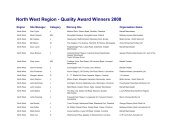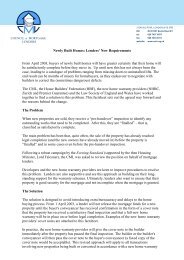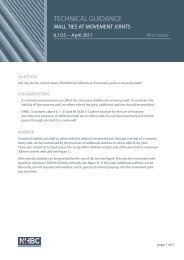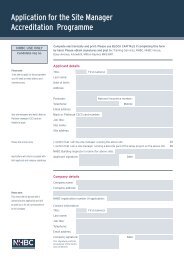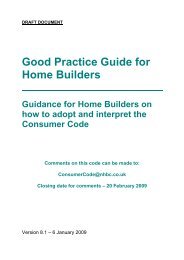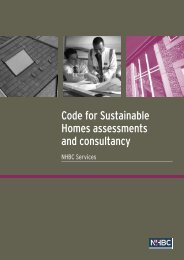Standards Extra - NHBC Home
Standards Extra - NHBC Home
Standards Extra - NHBC Home
Create successful ePaper yourself
Turn your PDF publications into a flip-book with our unique Google optimized e-Paper software.
Issue 43<br />
December 2008<br />
Secure escape<br />
In <strong>Standards</strong> <strong>Extra</strong> Issue 31 December 2004 we published<br />
an article about locks to individual flat entrance doors.<br />
The article explained the need to provide good security whilst<br />
still providing escape in the event of a fire without the need<br />
for a key i.e. keyless egress. Since that time <strong>NHBC</strong> has been<br />
working with representatives of the lock industry, police,<br />
insurers and the fire service in developing a suite of British<br />
<strong>Standards</strong> that cover security and means of escape for all<br />
types of dwellings.<br />
The first British Standard for locks, which addressed enhanced<br />
security for dwellings, was BS 3621 ‘Thief resistant lock assembly<br />
- Key egress’. The Standard covers single point locking<br />
operated by a key from both sides of a door. For locks which<br />
operate without the use of a key on the inside either via a<br />
thumb turn or handle, BS 8621 ‘Thief resistant lock assembly<br />
- Keyless egress’ was developed and published in 2004.<br />
BS 8621 locks provide keyless egress at all times but there<br />
may be times when it would be desirable to lock the internal<br />
thumb turn or handle when leaving a dwelling unoccupied.<br />
This feature is useful in preventing someone breaking in<br />
through a window and removing large items via the entrance<br />
door. To address this a further British Standard, BS 10621 ‘<br />
Thief resistant dual-mode lock assembly’ was developed and<br />
published in 2007. This lock has the facility to lock the<br />
internal thumb turn or handle by an extra operation of the<br />
key from the outside when leaving the property unoccupied.<br />
The latest editions of these three British <strong>Standards</strong> cover<br />
single point locks for all types of dwelling. In some cases it<br />
may be desirable to fit two locks to achieve sufficient<br />
resistance to forced entry and the recommended lock<br />
functions. An alternative would be to fit a multi-point lock,<br />
which has the same recommended lock functions.<br />
With different dwelling types it is important that the<br />
right lock(s) is fitted to ensure no one can accidentally<br />
become locked in or out of their own property. Below is<br />
a description of the lock functions that should be<br />
used in each dwelling type.<br />
Main entrance door<br />
Dwellings – All<br />
All entrance doors of individual dwellings should be<br />
fitted with one (or more) securely fixed lock and keep<br />
or multi-point locking system, which has:<br />
■ at least 1000 differs<br />
■ a fixing which, if burst open, would not pull<br />
out without breaking the door or its frame<br />
■ a hardened steel bolt or inserts to prevent sawing<br />
■ latch and deadlocking facility.<br />
Locking devices fitted to entrance doors should permit<br />
emergency egress without the use of a key when the<br />
dwelling is occupied.<br />
Any glazing which, if open or broken, would permit release<br />
of the thumb turn by hand or arm entry should be laminated.<br />
Dwellings - With an alternative means of escape.<br />
(These are typically houses with a front and rear door)<br />
Lock(s) should provide initial security by use of a latch<br />
operable with a key externally and a handle/thumb turn<br />
release internally. The full deadlocking facility should be<br />
engaged and be operable with a key externally and a<br />
handle/thumb turn release internally. Locks, which comply<br />
with BS 8621, meet these requirements. External handles<br />
on multi-point locking systems should be split spindle<br />
to avoid operating the latch.<br />
Enhanced security can also be achieved by providing the<br />
facility to deadlock the internal handle/thumb turn when<br />
leaving the dwelling un-occupied. Locks, which comply<br />
with BS 10621, meet these requirements.<br />
Dwellings - Without an alternative means of escape<br />
opening direct to outside. (These are typically ground<br />
floor flats or maisonettes)<br />
The door should be held close by use of a latch operable with<br />
a key externally and a handle/thumb turn release internally.<br />
The full deadlocking facility should be engaged and be<br />
operable with a key externally and a handle/thumb turn<br />
release internally. Locks, which comply with BS 8621, meet<br />
these requirements. External handles on multi-point locking<br />
systems should be split spindle to avoid operating the latch.<br />
Dwellings - Without an alternative means of escape<br />
opening onto a communal access. (These are typically<br />
flats accessed off a communal stairs)<br />
The door should be held close either on a latch operable<br />
with a handle both internally and externally or a roller bolt,<br />
so that the door cannot slam shut locking the homeowner out<br />
without a key. The full deadlocking facility should be engaged<br />
and be operable with a key externally and a handle/thumb<br />
turn release internally. Locks, which comply with BS 8621,<br />
meet these requirements.<br />
Secondary external access doors<br />
The door should be held closed on a latch and operable by<br />
use of a handle both internally and externally. A deadlocking<br />
facility should be operable by use of a key both internally<br />
and externally. Locks complying with BS 3621 meet these<br />
requirements. Alternatively a thumb turn may be used<br />
internally in place of a key operation. Locks complying with<br />
BS 8621 meet these re quirements. In addition bolts should<br />
be fixed securely at both top and bottom of the door on the<br />
internal opening edge. Where multi-point locking systems<br />
are used bolts may be omitted.<br />
ACTION<br />
When specifying door locks select the appropriate<br />
lock(s) that provides the recommended lock functions<br />
for the different dwelling types as stated above.<br />
7




